How to identify scams like "Secured Document"
Phishing/ScamAlso Known As: Secured Document phishing campaign
Get free scan and check if your device is infected.
Remove it nowTo use full-featured product, you have to purchase a license for Combo Cleaner. Seven days free trial available. Combo Cleaner is owned and operated by RCS LT, the parent company of PCRisk.com.
What is "Secured Document" email scam?
We have inspected the email and concluded that it is a scam email disguised as a notification regarding a signed and completed contract. Emails of this type are known as phishing emails, and scammers behind them aim to extract sensitive information from recipients. Thus, this (and similar) emails should be ignored.
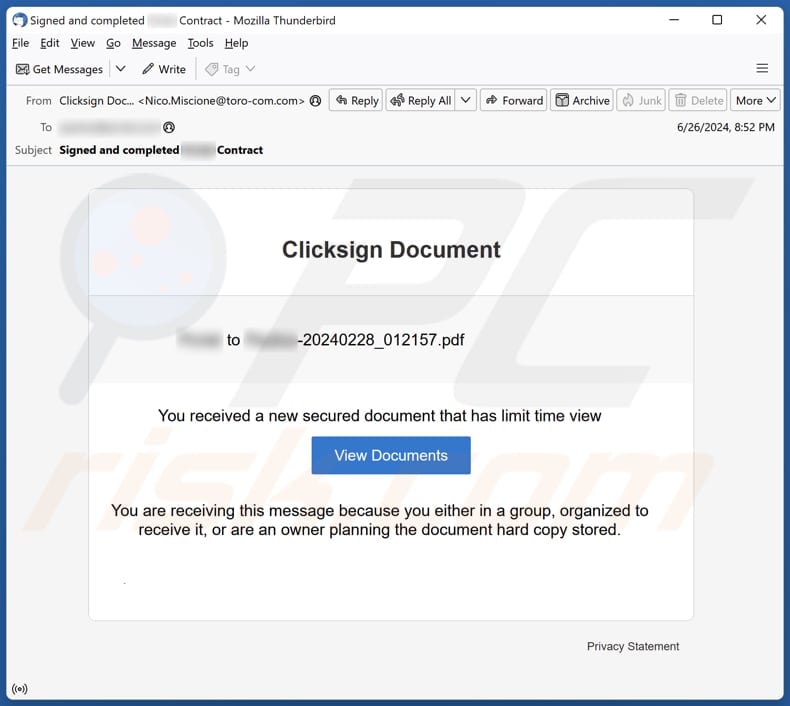
More about the "Secured Document" scam email
The email claims that the recipient has received a new secured document ("20240228_012157.pdf") and instructs to click on a link labeled "View Documents". It also tries to create urgency by suggesting that the document is time-sensitive. Additionally, the email explains why the recipient has received this message.
Clicking the provided link leads to a fake Sender[.] net sign-in page that requests email account login credentials (an email address and password). Once entered, these credentials are collected by the scammers behind the phishing campaign. Scammers can exploit this information in several malicious ways.
For instance, they can use the compromised email account to send out phishing emails to the victim's contacts and look for emails containing other sensitive information (e.g., credit card details, ID card information, or social security numbers). They can also spread malware by tricking recipients into clicking malicious links or downloading infected attachments.
Moreover, scammers can compromise other accounts linked to the victim's email address or the accounts that use the same or a similar password. Thus, falling for such scams can lead to financial loss, identity theft, reputational damage, and other issues. Recipients should be careful with suspicious emails to avoid possible consequences.
| Name | Secured Document Email Scam |
| Threat Type | Phishing, Scam, Social Engineering, Fraud |
| Fake Claim | The email contains a secured document |
| Disguise | Letter regarding a signed and completed contract |
| Symptoms | Unauthorized online purchases, changed online account passwords, identity theft, illegal access of the computer. |
| Distribution methods | Deceptive emails, rogue online pop-up ads, search engine poisoning techniques, misspelled domains. |
| Damage | Loss of sensitive private information, monetary loss, identity theft. |
| Malware Removal (Windows) |
To eliminate possible malware infections, scan your computer with legitimate antivirus software. Our security researchers recommend using Combo Cleaner. Download Combo CleanerTo use full-featured product, you have to purchase a license for Combo Cleaner. 7 days free trial available. Combo Cleaner is owned and operated by RCS LT, the parent company of PCRisk.com. |
Similar scam emails in general
Phishing emails are fraudulent messages designed to deceive recipients into disclosing sensitive information, such as login credentials, financial details, or other personal data. Scammers behind them often impersonate entities like banks, government agencies, popular websites, etc. These emails typically contain links to fake websites that mimic legitimate ones.
It is important to note that cybercriminals behind fraudulent emails can include links or attachments meant to trick users into infecting their computers. Some examples of emails similar to the one described in our article are "Someone Added You As Their Recovery", "Webmail - Confirm Domain Ownership", and "Bank Account Details".
How do spam campaigns infect computers?
Emails designed to distribute malware include malicious links and attachments (files). The intent is to deceive recipients into unwittingly downloading and activating malware on their computers. Links presented in such emails can direct users to pages that automatically download malware or deceive them into downloading malicious files.
Attachments in malicious emails can infect computers through various methods. For example, malicious Microsoft Office documents can inject malware after enabling macros commands and malicious executable files can infect computers when they are opened/executed. Other types of files commonly used to distribute malware include PDFs, archives (e.g., ZIP files), ISO files, and JavaScript files.
How to avoid installation of malware?
Download software (and files) from official websites or reputable app stores. Do not download pirated software, cracking tools, key generators, or trust advertisements (various pop-ups) encountered on suspicious websites. Also, do not consent to receive notifications from pages of this kind.
Furthermore, be cautious with unexpected emails received from unknown addresses. Do not open links or files included in such emails. Regularly update the operating system and software and use reputable security software. If you have already opened malicious attachments, we recommend running a scan with Combo Cleaner Antivirus for Windows to automatically eliminate infiltrated malware.
Text presented in the "Secured Document" email letter:
Subject: Signed and completed ******** Contract
Clicksign Document******** to ********-20240228_012157.pdf
You received a new secured document that has limit time view
View Documents
You are receiving this message because you either in a group, organized to receive it, or are an owner planning the document hard copy stored.
Screenshot of the phishing page used in this scam:
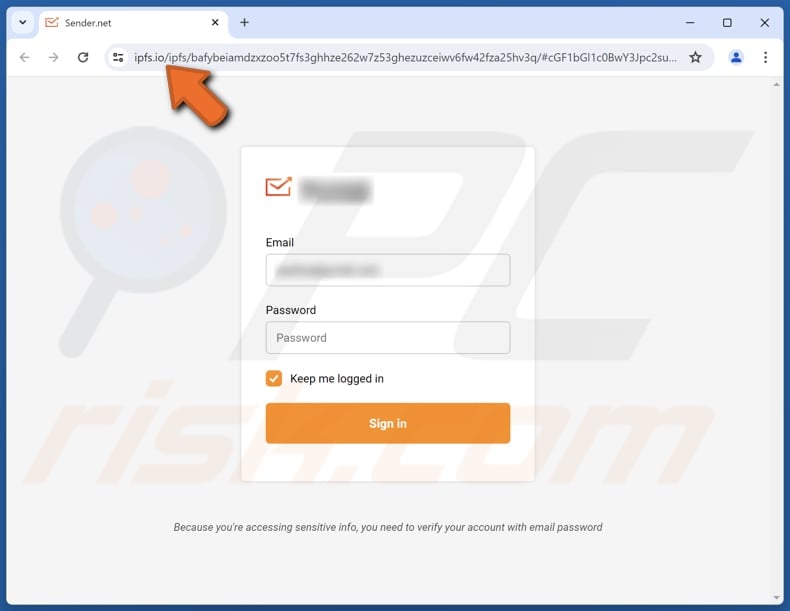
Another example of an email from "Secured Document" spam campaign:
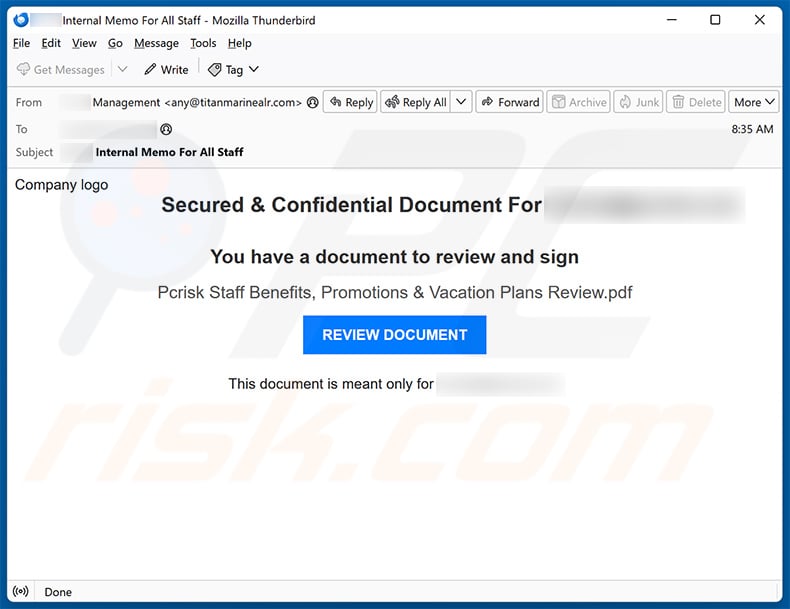
Text presented within:
Subject: ******** Internal Memo For All Staff
Secured & Confidential Document For ********
You have a document to review and sign
******** Staff Benefits, Promotions & Vacation Plans Review.pdf
REVIEW DOCUMENT
This document is meant only for ********
Screenshot of the promoted phishing site:
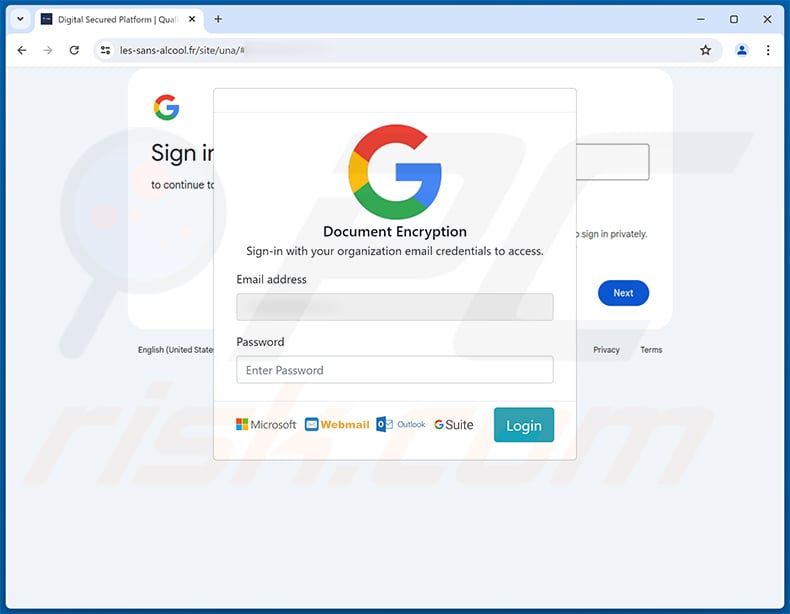
Another example of an email from "Secured Document" spam campaign:
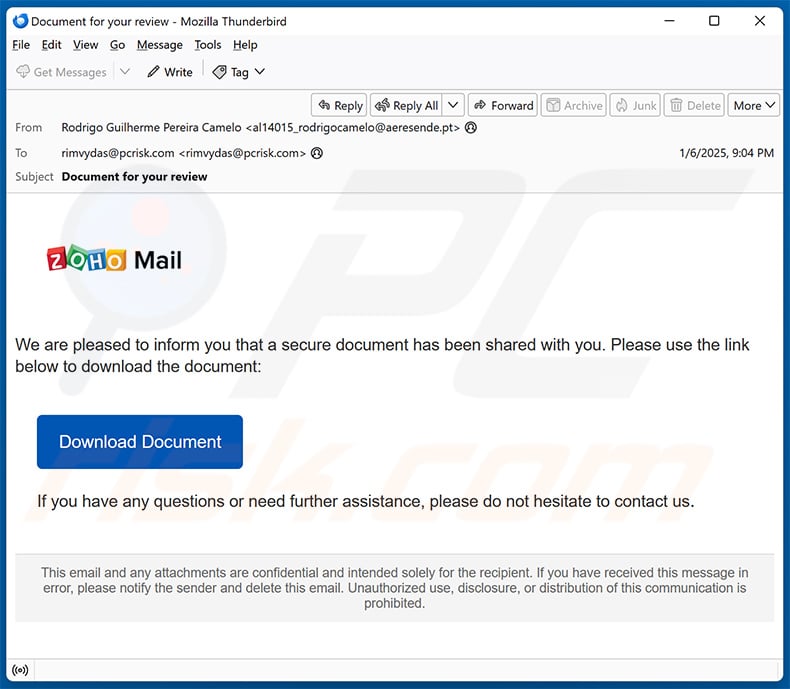
Text presented within:
Subject: Document for your review
We are pleased to inform you that a secure document has been shared with you. Please use the link below to download the document:
Download Document
If you have any questions or need further assistance, please do not hesitate to contact us.
This email and any attachments are confidential and intended solely for the recipient. If you have received this message in error, please notify the sender and delete this email. Unauthorized use, disclosure, or distribution of this communication is prohibited.
Screenshot of the promoted phishing site:
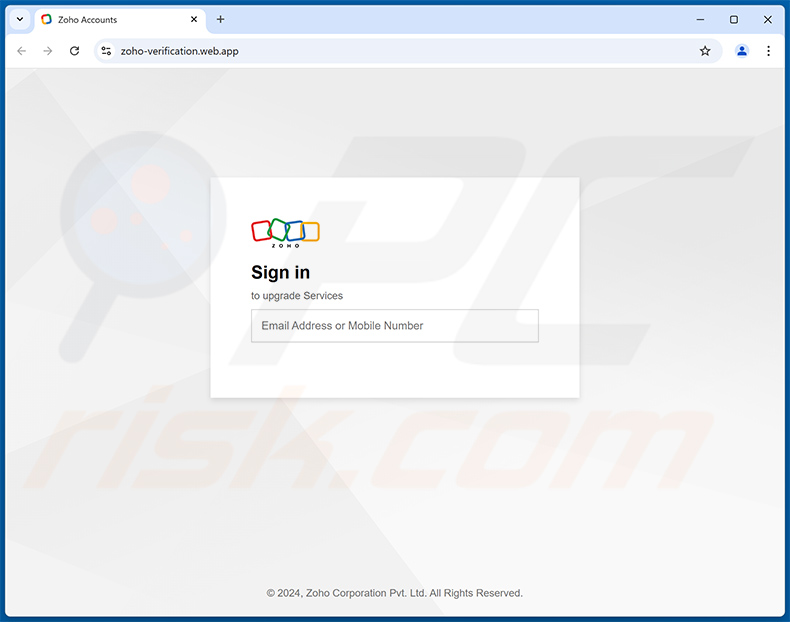
Instant automatic malware removal:
Manual threat removal might be a lengthy and complicated process that requires advanced IT skills. Combo Cleaner is a professional automatic malware removal tool that is recommended to get rid of malware. Download it by clicking the button below:
DOWNLOAD Combo CleanerBy downloading any software listed on this website you agree to our Privacy Policy and Terms of Use. To use full-featured product, you have to purchase a license for Combo Cleaner. 7 days free trial available. Combo Cleaner is owned and operated by RCS LT, the parent company of PCRisk.com.
Quick menu:
- What is Secured Document phishing campaign?
- Types of malicious emails.
- How to spot a malicious email?
- What to do if you fell for an email scam?
Types of malicious emails:
![]() Phishing Emails
Phishing Emails
Most commonly, cybercriminals use deceptive emails to trick Internet users into giving away their sensitive private information, for example, login information for various online services, email accounts, or online banking information.
Such attacks are called phishing. In a phishing attack, cybercriminals usually send an email message with some popular service logo (for example, Microsoft, DHL, Amazon, Netflix), create urgency (wrong shipping address, expired password, etc.), and place a link which they hope their potential victims will click on.
After clicking the link presented in such email message, victims are redirected to a fake website that looks identical or extremely similar to the original one. Victims are then asked to enter their password, credit card details, or some other information that gets stolen by cybercriminals.
![]() Emails with Malicious Attachments
Emails with Malicious Attachments
Another popular attack vector is email spam with malicious attachments that infect users' computers with malware. Malicious attachments usually carry trojans that are capable of stealing passwords, banking information, and other sensitive information.
In such attacks, cybercriminals' main goal is to trick their potential victims into opening an infected email attachment. To achieve this goal, email messages usually talk about recently received invoices, faxes, or voice messages.
If a potential victim falls for the lure and opens the attachment, their computers get infected, and cybercriminals can collect a lot of sensitive information.
While it's a more complicated method to steal personal information (spam filters and antivirus programs usually detect such attempts), if successful, cybercriminals can get a much wider array of data and can collect information for a long period of time.
![]() Sextortion Emails
Sextortion Emails
This is a type of phishing. In this case, users receive an email claiming that a cybercriminal could access the webcam of the potential victim and has a video recording of one's masturbation.
To get rid of the video, victims are asked to pay a ransom (usually using Bitcoin or another cryptocurrency). Nevertheless, all of these claims are false - users who receive such emails should ignore and delete them.
How to spot a malicious email?
While cyber criminals try to make their lure emails look trustworthy, here are some things that you should look for when trying to spot a phishing email:
- Check the sender's ("from") email address: Hover your mouse over the "from" address and check if it's legitimate. For example, if you received an email from Microsoft, be sure to check if the email address is @microsoft.com and not something suspicious like @m1crosoft.com, @microsfot.com, @account-security-noreply.com, etc.
- Check for generic greetings: If the greeting in the email is "Dear user", "Dear @youremail.com", "Dear valued customer", this should raise suspiciousness. Most commonly, companies call you by your name. Lack of this information could signal a phishing attempt.
- Check the links in the email: Hover your mouse over the link presented in the email, if the link that appears seems suspicious, don't click it. For example, if you received an email from Microsoft and the link in the email shows that it will go to firebasestorage.googleapis.com/v0... you shouldn't trust it. It's best not to click any links in the emails but to visit the company website that sent you the email in the first place.
- Don't blindly trust email attachments: Most commonly, legitimate companies will ask you to log in to their website and to view any documents there; if you received an email with an attachment, it's a good idea to scan it with an antivirus application. Infected email attachments are a common attack vector used by cybercriminals.
To minimise the risk of opening phishing and malicious emails we recommend using Combo Cleaner Antivirus for Windows.
Example of a spam email:

What to do if you fell for an email scam?
- If you clicked on a link in a phishing email and entered your password - be sure to change your password as soon as possible. Usually, cybercriminals collect stolen credentials and then sell them to other groups that use them for malicious purposes. If you change your password in a timely manner, there's a chance that criminals won't have enough time to do any damage.
- If you entered your credit card information - contact your bank as soon as possible and explain the situation. There's a good chance that you will need to cancel your compromised credit card and get a new one.
- If you see any signs of identity theft - you should immediately contact the Federal Trade Commission. This institution will collect information about your situation and create a personal recovery plan.
- If you opened a malicious attachment - your computer is probably infected, you should scan it with a reputable antivirus application. For this purpose, we recommend using Combo Cleaner Antivirus for Windows.
- Help other Internet users - report phishing emails to Anti-Phishing Working Group, FBI’s Internet Crime Complaint Center, National Fraud Information Center and U.S. Department of Justice.
Frequently Asked Questions (FAQ)
Why did I receive this email?
Scammers send the same phishing email to numerous email addresses at once. In most cases, they gather email addresses from hacked databases, purchased lists, or through similar methods. Their objective is to target a wide range of potential victims.
I have provided my personal information when tricked by this email, what should I do?
If you have disclosed any account credentials, it is crucial to change all passwords immediately to secure your accounts. Additionally, monitor your accounts closely for any suspicious activity.
I have downloaded and opened a malicious file attached to an email, is my computer infected?
If the file was an executable, then it is highly likely that malware has been activated on your system. However, if it was a document such as a .pdf or .doc file, there is a chance you may have avoided infection.
I have read the email but did not open the attachment, is my computer infected?
No, it is safe to open emails even if they contain malicious links or files.
Will Combo Cleaner remove malware infections that were present in email attachment?
Combo Cleaner effectively identifies and removes nearly all known malware. Sophisticated malware often embeds itself deep within the system, where it can evade detection. Therefore, users are advised to run a full system scan to detect and eliminate malware of this kind.
Share:

Tomas Meskauskas
Expert security researcher, professional malware analyst
I am passionate about computer security and technology. I have an experience of over 10 years working in various companies related to computer technical issue solving and Internet security. I have been working as an author and editor for pcrisk.com since 2010. Follow me on Twitter and LinkedIn to stay informed about the latest online security threats.
PCrisk security portal is brought by a company RCS LT.
Joined forces of security researchers help educate computer users about the latest online security threats. More information about the company RCS LT.
Our malware removal guides are free. However, if you want to support us you can send us a donation.
DonatePCrisk security portal is brought by a company RCS LT.
Joined forces of security researchers help educate computer users about the latest online security threats. More information about the company RCS LT.
Our malware removal guides are free. However, if you want to support us you can send us a donation.
Donate
▼ Show Discussion